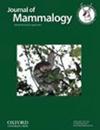受伤但不紧张驼鹿在北方森林中容忍有害苍蝇
IF 1.6
3区 生物学
Q2 ZOOLOGY
引用次数: 0
摘要
北方栖息地的驼鹿(Alces alces)在觅食和休息时会接触到双翅目苍蝇及其携带的寄生虫。我们在夏季从阿拉斯加基奈半岛的 12 只栖息驼鹿身上收集了 31905 只苍蝇。收集到的苍蝇中,驼鹿蝇(Haematobosca alcis (Snow),双翅目:麝科--在驼鹿身上或周围完成整个生命周期的物种--占 91%;提醒收集到的苍蝇包括蚊蝇(Culicidae)、黑蝇(Simuliidae)和鹿蝇(Tabanidae)。苍蝇会给驼鹿带来生理代价,例如成为寄生虫的传播媒介,如腿线虫(Onchocerca spp.),这种寄生虫会导致驼鹿后腿生疮。我们发现,驼鹿后腿上溃疡的数量与体脂呈正相关,这表明能量的增加与苍蝇的损害之间存在关联。我们还发现,疮的数量与血清白蛋白呈负相关,这表明炎症反应和体内蛋白质被用来修复苍蝇和寄生虫造成的损伤。麋鹿身上苍蝇的数量或种类与唾液或粪便中皮质类固醇的浓度无关。苍蝇不会引起驼鹿的应激反应,尽管修复伤口和抵抗伤口感染的成本可能会减少夏季觅食所获得的蛋白质。驼鹿可以忍受叮咬苍蝇造成的伤害,并从夏季觅食中获得正常收益,但接触昆虫传播的寄生虫会给繁殖和生存带来风险。本文章由计算机程序翻译,如有差异,请以英文原文为准。
Wounded but unstressed: Moose tolerate injurious flies in the boreal forest
Moose (Alces alces) in boreal habitats feed and rest where they are exposed to Dipteran flies and the parasites they carry. We collected 31,905 flies during the summer from 12 habituated moose on the Kenai Peninsula, Alaska. Moose flies, Haematobosca alcis (Snow), Diptera: Muscidae—a species that completes its entire life cycle on or around moose—accounted for 91% of flies collected; the reminder of the flies collected included mosquitoes (Culicidae), black flies (Simuliidae), and deer flies (Tabanidae). Flies impose physiological costs for moose, e.g., vectors for parasites such as Legworm (Onchocerca spp.) which causes sores on the hind legs of moose. We found that the number of sores present on the hind legs of moose is positively correlated with body fat, which suggests a correlation between gains of energy and damage from flies. We also found that the number of sores is negatively correlated with serum albumin, which is indicative of an inflammatory response and body protein being used to repair injuries from flies and parasites. The number or type of flies present on a Moose were not correlated with the concentration of corticosteroids in saliva or feces. Flies do not elicit a stress response in moose even though the costs of repairing wounds and resisting infections of those wounds likely reduce gains of protein from summer foraging. Moose can tolerate the injuries from biting flies with regular gains from summer foraging but exposure to insect-borne parasites poses a risk to reproduction and survival.
求助全文
通过发布文献求助,成功后即可免费获取论文全文。
去求助
来源期刊

Journal of Mammalogy
生物-动物学
CiteScore
3.30
自引率
5.90%
发文量
106
审稿时长
4-8 weeks
期刊介绍:
Papers are published on mammalian behavior, conservation, ecology, genetics, morphology, physiology, and taxonomy.
 求助内容:
求助内容: 应助结果提醒方式:
应助结果提醒方式:


